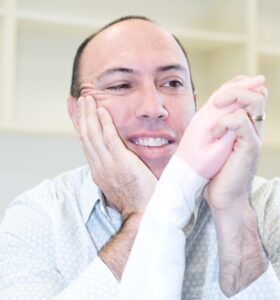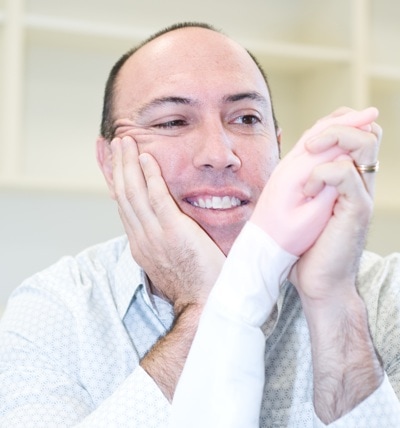Our last rubber hand illusion paper attracted this comment from one of the reviewers: ‘it would take something very special to get yet another study on the rubber hand illusion into a journal like this one’. We were pretty sympathetic to the reviewer because there really are a tonne of them out there. Here is one that was actually published a year ago, but it took a slightly different angle on the illusion by asking whether the illusion could be induced without using tactile input. That is, can the illusion be induced with simply movement and vision? This is how they did it: get a supposedly normal healthy volunteer to put on a haptic glove. A haptic glove has motion sensors in it that work like artificial proprioceptors. The signals that are generated when the subject moves their hand are used to drive a virtual hand that is projected onto a screen in front of the volunteer. The virtual hand is clearly a fake – check out the images in the paper, which also has a movie of it all in action. Nonetheless, that the virtual hand does everything your real hand does induces a vivid illusion indeed. The authors, from Mel Slater’s group in Spain (Mel has already had a good show on BodyinMind.org) claim that their study shows that the illusion can be induced on the basis of visuomotor interaction alone. I don’t think they have shown this though – the hand was not anaesthetised so there might have been proprioceptive and tactile feedback. How can we conclude then that it is the congruence between what you command and what you see and not the congruence between sensory feedback in the proprioceptive/cutaneous and visual domains? I don’t think we can.
When this study was in the final throws of getting published, we were in the midst of some experiments that were asking the same question. We used the fake finger illusion. By using a finger instead of an arm, it is possible to remove sensory input from the joints and skin of the finger without affecting its movement. One blocks the digital nerve, which has no effect on the finger muscles, which are in the forearm. That study showed quite clearly that visuomotor integration induced the illusion at least as well as visuotactile does. There was a surprise though – the illusion was just as strong when the fake and real finger were moved passively as it was when they were moved actively. This is intriguing because it suggests that the proprioceptive signals from the receptors in the muscles that move the finger might underpin the illusion, not the movement itself. So, in a sense, we only made a small advance on the work by Slater et al. That is, they showed that movement commands plus proprioception from the hand and muscles, integrated with vision, induces the illusion. We showed that movement commands plus proprioception from the muscles alone, integrated with vision, induces the illusion and that the movement commands are not critical. To prove that movement commands alone can do it, one would need to remove all proprioceptive input. Possible? Probably – check this out from Mel Slater’s group again (in conjunction with the indefatigable Henrik Ehrsson). Here they used a brain-computer interface, trained people to open and close a virtual hand and noted that the command alone was able to induce a sense of ownership over the virtual hand. Let me clarify – they just commanded the hand to open and it did. They did not move their own hand. Cool huh? Well there is a catch – there was no shift in the perceived location of their own hand, a thing called proprioceptive drift. Proprioceptive drift is considered the more objective measure of the illusion so there is a chance that what they detected here was a reporting bias. Still, very groovy stuff.
So what? Well I must admit that the normal talk here of future applications in virtual body control for military use or remote surgery feels a little flat. However, we do know that there are positive effects of embedding prosthetic limbs early after amputation but that not all denervated or amputated limbs can be replaced with a prosthesis. Perhaps we are seeing here a patch of road that is headed for better options for amputees and spinal cord injured patients. Wherever it goes, it continues to unwrap the tangled mess of body ownership, even if a small thread at a time. Finally, in case you are interested, there are some groovy movies available here.
About Lorimer Moseley
 Lorimer is NHMRC Senior Research Fellow with twenty years clinical experience working with people in pain. After spending some time as a Nuffield Medical Research Fellow at Oxford University he returned to Australia in 2009 to take up an NHMRC Senior Research Fellowship at Neuroscience Research Australia (NeuRA). In 2011, he was appointed Professor of Clinical Neurosciences & the Inaugural Chair in Physiotherapy at the University of South Australia, Adelaide. He runs the Body in Mind research groups. He is the only Clinical Scientist to have knocked over a water tank tower in Outback Australia.
Lorimer is NHMRC Senior Research Fellow with twenty years clinical experience working with people in pain. After spending some time as a Nuffield Medical Research Fellow at Oxford University he returned to Australia in 2009 to take up an NHMRC Senior Research Fellowship at Neuroscience Research Australia (NeuRA). In 2011, he was appointed Professor of Clinical Neurosciences & the Inaugural Chair in Physiotherapy at the University of South Australia, Adelaide. He runs the Body in Mind research groups. He is the only Clinical Scientist to have knocked over a water tank tower in Outback Australia.
Link to Lorimer’s published research here. Downloadable PDFs here.
References

Sanchez-Vives MV, Spanlang B, Frisoli A, Bergamasco M, Slater M, 2010 Virtual Hand Illusion Induced by Visuomotor Correlations. PLoS ONE 5(4): e10381. doi:10.1371/journal.pone.0010381
Walsh LD, Moseley GL, Taylor JL, & Gandevia SC (2011). Proprioceptive signals contribute to the sense of body ownership. The Journal of physiology, 589 (Pt 12), 3009-21 PMID: 21521765
Slater M, Perez-Marcos D, Ehrsson HH, & Sanchez-Vives MV (2009). Inducing illusory ownership of a virtual body. Frontiers in neuroscience, 3 (2), 214-20 PMID: 20011144
Lotze M, Grodd W, Birbaumer N, Erb M, Huse E, & Flor H (1999). Does use of a myoelectric prosthesis prevent cortical reorganization and phantom limb pain? Nature neuroscience, 2 (6), 501-2 PMID: 10448212



